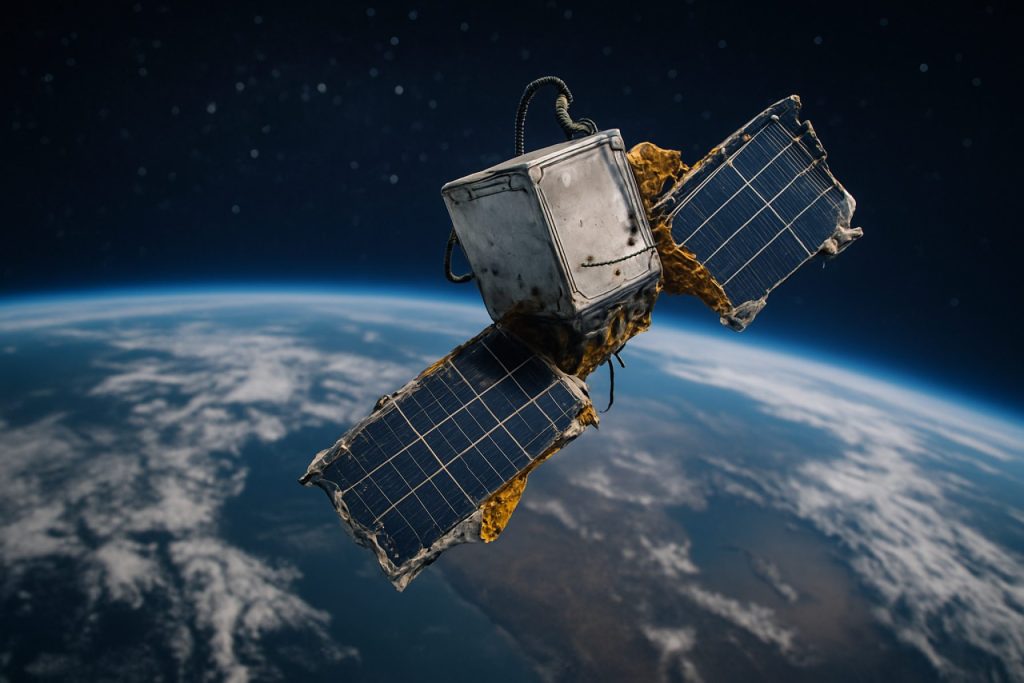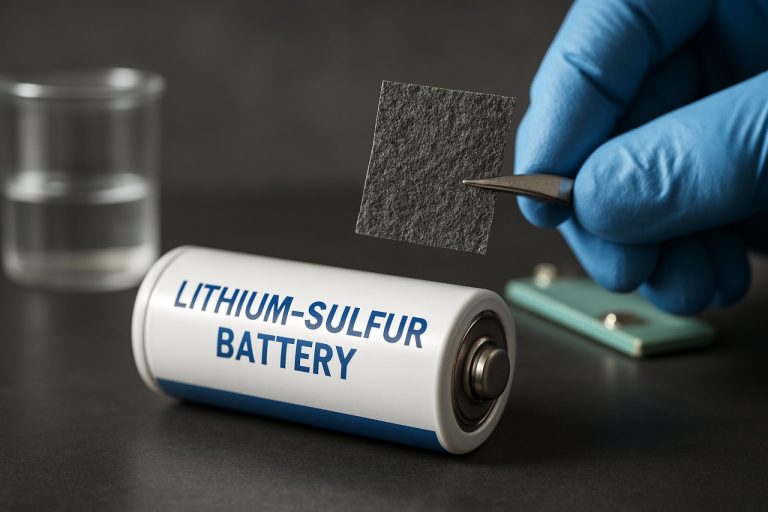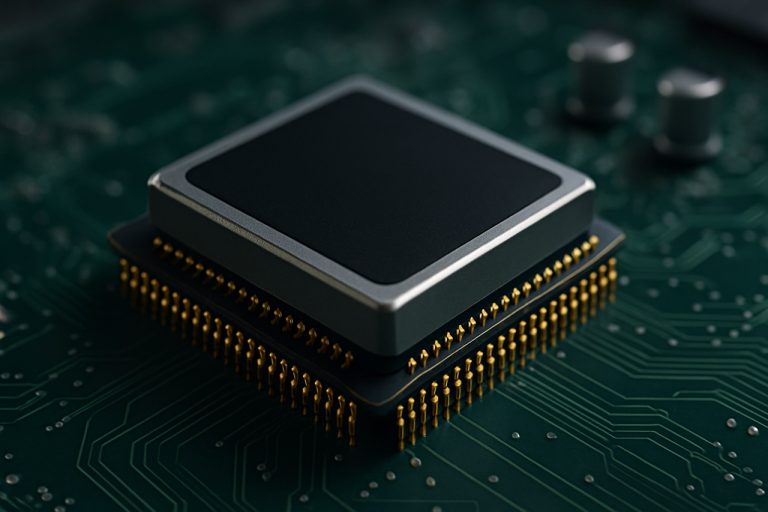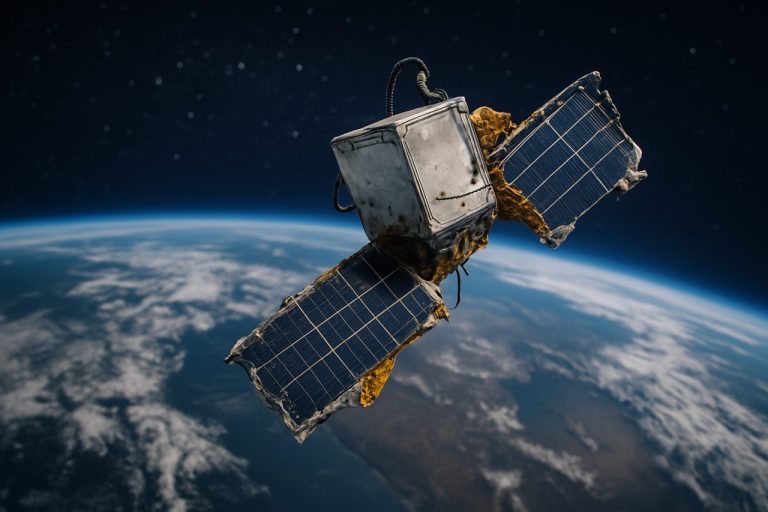
Satellite Debris Mitigation Technologies Market Report 2025: In-Depth Analysis of Growth Drivers, Innovations, and Global Impact. Explore Market Size, Leading Players, and Strategic Opportunities Shaping the Next 5 Years.
- Executive Summary & Market Overview
- Key Technology Trends in Satellite Debris Mitigation
- Competitive Landscape and Leading Players
- Market Growth Forecasts 2025–2030: CAGR, Revenue, and Volume Projections
- Regional Analysis: North America, Europe, Asia-Pacific, and Rest of World
- Future Outlook: Emerging Solutions and Investment Hotspots
- Challenges, Risks, and Strategic Opportunities
- Sources & References
Executive Summary & Market Overview
The satellite debris mitigation technologies market is rapidly evolving in response to the escalating challenge of space debris in Earth’s orbit. As of 2025, the proliferation of satellites—driven by the expansion of commercial constellations and governmental space initiatives—has intensified concerns over orbital congestion and collision risks. Satellite debris mitigation technologies encompass a range of solutions designed to prevent, reduce, or remediate the accumulation of non-functional satellites, spent rocket stages, and fragmentation debris in space.
According to European Space Agency (ESA) data, over 36,000 trackable debris objects are currently in orbit, with millions of smaller, untrackable fragments posing significant threats to operational spacecraft. The market for mitigation technologies is thus underpinned by both regulatory imperatives and commercial risk management. Key drivers include the adoption of international guidelines such as the United Nations Office for Outer Space Affairs (UNOOSA) Space Debris Mitigation Guidelines and the increasing enforcement of end-of-life disposal requirements by agencies like the Federal Communications Commission (FCC).
The market landscape in 2025 is characterized by a mix of established aerospace firms and innovative startups. Companies such as Northrop Grumman, Airbus, and Astroscale are at the forefront, developing technologies ranging from active debris removal (ADR) systems—such as robotic arms, nets, and harpoons—to advanced propulsion modules for controlled deorbiting. The emergence of in-orbit servicing and refueling further complements debris mitigation by extending satellite lifespans and reducing the frequency of uncontrolled derelicts.
Market research by MarketsandMarkets projects the global satellite debris mitigation market to grow at a CAGR exceeding 8% through 2030, driven by increasing satellite launches and heightened regulatory scrutiny. Regional growth is particularly robust in North America and Europe, where government funding and public-private partnerships are accelerating technology adoption. Meanwhile, Asia-Pacific nations are ramping up investments, reflecting their expanding presence in the global space economy.
In summary, the satellite debris mitigation technologies market in 2025 is defined by urgent demand, regulatory momentum, and rapid technological innovation. The sector is poised for sustained growth as stakeholders across the space industry prioritize orbital sustainability and operational safety.
Key Technology Trends in Satellite Debris Mitigation
Satellite debris mitigation technologies are rapidly evolving in response to the growing threat posed by space debris in Earth’s orbit. As of 2025, the industry is witnessing a surge in innovative solutions aimed at both preventing the creation of new debris and actively removing existing objects. These advancements are driven by the increasing density of satellites, particularly in low Earth orbit (LEO), and the heightened risk of collisions that could jeopardize critical space infrastructure.
One of the most significant trends is the development of active debris removal (ADR) systems. Companies and agencies are investing in technologies such as robotic arms, nets, harpoons, and ion-beam shepherds to capture and deorbit defunct satellites and large debris fragments. For example, the European Space Agency’s European Space Agency ClearSpace-1 mission, scheduled for launch in the mid-2020s, will demonstrate the viability of using a robotic arm to capture and remove debris. Similarly, private firms like Astroscale are advancing magnetic docking and capture mechanisms, with their ELSA-d mission showcasing in-orbit debris retrieval and controlled deorbiting.
Another key trend is the integration of end-of-life (EOL) technologies into satellite design. Satellite manufacturers are increasingly equipping spacecraft with propulsion systems or drag-enhancing devices, such as deployable sails, to ensure rapid deorbiting at the end of operational life. These measures are being adopted in response to stricter international guidelines and national regulations, such as the U.S. Federal Communications Commission’s (FCC) five-year deorbit rule for LEO satellites (Federal Communications Commission).
Artificial intelligence (AI) and advanced tracking technologies are also playing a pivotal role. Enhanced space situational awareness (SSA) platforms leverage AI-driven algorithms to predict collision risks and optimize avoidance maneuvers. Companies like LeoLabs are deploying ground-based radar networks and cloud-based analytics to provide real-time tracking of debris as small as 2 cm, significantly improving the industry’s ability to monitor and respond to threats.
Finally, international collaboration and standardization efforts are accelerating. Organizations such as the United Nations Office for Outer Space Affairs are working with industry stakeholders to establish best practices and technical standards for debris mitigation, fostering a more coordinated global response to the debris challenge.
Competitive Landscape and Leading Players
The competitive landscape for satellite debris mitigation technologies in 2025 is characterized by a dynamic mix of established aerospace giants, specialized startups, and collaborative international initiatives. As the proliferation of satellites in low Earth orbit (LEO) accelerates, driven by mega-constellations and commercial space activities, the urgency for effective debris mitigation has intensified. This has spurred significant investment and innovation, with market participants vying to develop scalable, cost-effective solutions for both active debris removal (ADR) and preventative measures.
Leading players in this sector include Northrop Grumman, which leverages its extensive experience in space systems to develop robotic servicing and debris capture technologies. Airbus has advanced its “RemoveDEBRIS” project, demonstrating net and harpoon capture techniques in orbit, and continues to refine these systems for commercial deployment. Astroscale, a pioneering startup, has emerged as a global leader in end-of-life (EOL) satellite servicing and debris removal, with its ELSA-d mission successfully demonstrating magnetic capture and controlled deorbiting of defunct satellites.
In the United States, Lockheed Martin and Boeing are investing in modular satellite architectures and on-orbit servicing capabilities, aiming to extend satellite lifespans and reduce the creation of new debris. Meanwhile, European Space Agency (ESA) and Japan Aerospace Exploration Agency (JAXA) are spearheading international collaborations, such as the ClearSpace-1 mission, which targets the removal of large debris objects using robotic arms.
- Astroscale: Focused on commercial debris removal and EOL services, with operational demonstrations in LEO.
- Airbus: Innovator in net and harpoon capture systems, with successful in-orbit tests.
- Northrop Grumman: Developing robotic servicing and debris capture solutions.
- Lockheed Martin & Boeing: Advancing modular satellite designs and on-orbit servicing to minimize debris generation.
- ESA & JAXA: Leading government-backed missions for large-scale debris removal and international standard-setting.
The market is also witnessing the entry of new players offering AI-driven tracking, autonomous rendezvous, and propulsion-based deorbiting solutions. Strategic partnerships, government contracts, and regulatory frameworks are shaping the competitive dynamics, with a clear trend toward public-private collaboration to address the growing challenge of orbital debris.
Market Growth Forecasts 2025–2030: CAGR, Revenue, and Volume Projections
The market for satellite debris mitigation technologies is poised for robust growth between 2025 and 2030, driven by escalating concerns over space debris and the increasing frequency of satellite launches. According to projections by MarketsandMarkets, the global market for space debris removal and mitigation is expected to register a compound annual growth rate (CAGR) of approximately 18–20% during this period. This surge is attributed to both regulatory pressures and the commercial imperative to protect valuable satellite assets in low Earth orbit (LEO).
Revenue forecasts indicate that the market, valued at around USD 1.2 billion in 2025, could surpass USD 2.7 billion by 2030. This growth is underpinned by increased investments from both governmental agencies and private sector players, as well as the emergence of new business models such as debris removal-as-a-service. Notably, the European Space Agency’s (ESA) ClearSpace-1 mission and similar initiatives by Astroscale Holdings Inc. and Northrop Grumman Corporation are expected to catalyze market expansion by demonstrating the technical and commercial viability of active debris removal.
In terms of volume, the number of mitigation missions—including both active debris removal and in-orbit servicing—is projected to grow from fewer than 10 missions in 2025 to over 50 missions annually by 2030, as per estimates from Euroconsult. This increase reflects not only the proliferation of small satellite constellations but also the growing adoption of end-of-life and passivation technologies by satellite operators.
- CAGR (2025–2030): 18–20%
- Revenue (2025): USD 1.2 billion
- Revenue (2030): USD 2.7 billion+
- Annual Mitigation Missions (2025): <10
- Annual Mitigation Missions (2030): 50+
Overall, the satellite debris mitigation technologies market is set for accelerated expansion, with regulatory frameworks, insurance requirements, and the operational needs of mega-constellations acting as primary growth drivers through 2030.
Regional Analysis: North America, Europe, Asia-Pacific, and Rest of World
The regional landscape for satellite debris mitigation technologies in 2025 is shaped by varying levels of investment, regulatory frameworks, and technological capabilities across North America, Europe, Asia-Pacific, and the Rest of the World.
- North America: The United States leads the global market, driven by robust funding from both government agencies such as NASA and the U.S. Department of Defense, as well as private sector innovation from companies like Northrop Grumman and Lockheed Martin. The region benefits from advanced R&D infrastructure and a proactive regulatory environment, exemplified by the Federal Communications Commission’s updated orbital debris mitigation rules. North America is at the forefront of active debris removal (ADR) demonstrations and the integration of AI-driven tracking systems.
- Europe: Europe is a significant player, with the European Space Agency (ESA) spearheading collaborative projects such as the ClearSpace-1 mission, which aims to remove defunct satellites from orbit. The region’s regulatory approach is harmonized through the European Commission, fostering cross-border partnerships and funding for startups like Astroscale (with a strong European presence). Europe’s focus is on both prevention—through stringent satellite design standards—and remediation, with a growing emphasis on sustainability in space operations.
- Asia-Pacific: The Asia-Pacific region is rapidly expanding its capabilities, led by countries such as Japan, China, and India. Japan’s JAXA collaborates with private firms on ADR technologies, while China’s CNSA is investing in debris tracking and removal missions. India’s ISRO is developing indigenous solutions for debris monitoring. The region faces challenges related to regulatory harmonization but is expected to see the fastest growth in market adoption due to increasing satellite launches and government support.
- Rest of World: Other regions, including the Middle East, Africa, and Latin America, are in the early stages of adopting debris mitigation technologies. Efforts are primarily focused on compliance with international guidelines set by the United Nations Office for Outer Space Affairs (UNOOSA) and capacity building. However, as these regions increase their satellite deployment, demand for cost-effective mitigation solutions is expected to rise.
Overall, while North America and Europe currently dominate the satellite debris mitigation market, Asia-Pacific is poised for significant growth, and the Rest of the World is gradually entering the sector as space activities globalize.
Future Outlook: Emerging Solutions and Investment Hotspots
The future outlook for satellite debris mitigation technologies in 2025 is shaped by a convergence of regulatory pressure, technological innovation, and heightened investor interest. As the proliferation of satellites—particularly from mega-constellations—intensifies, the risk of collisions and cascading debris events (Kessler Syndrome) has become a critical concern for both governmental and commercial stakeholders. This has catalyzed a surge in R&D and investment targeting advanced debris mitigation and removal solutions.
Emerging solutions in 2025 are increasingly focused on active debris removal (ADR) and in-orbit servicing. Technologies such as robotic arms, nets, harpoons, and laser-based systems are being developed and tested to capture, deorbit, or reposition defunct satellites and large debris fragments. Notably, companies like Astroscale Holdings and ClearSpace are leading the charge with demonstration missions scheduled or underway, aiming to validate the commercial viability of ADR services. Additionally, satellite manufacturers are integrating end-of-life deorbiting mechanisms, such as drag sails and propulsion modules, to comply with evolving international guidelines and reduce long-term debris risks.
- Laser-based Debris Removal: Research institutions and startups are advancing ground- and space-based laser systems to nudge small debris into lower orbits for atmospheric burn-up. This approach is gaining traction due to its scalability and non-contact nature.
- On-orbit Servicing: Technologies enabling refueling, repair, and repositioning of satellites are being developed to extend operational lifespans and prevent the creation of new debris. Northrop Grumman’s Mission Extension Vehicle is a prominent example of commercial servicing in action.
- AI-driven Collision Avoidance: Advanced software platforms are leveraging artificial intelligence to predict and autonomously maneuver satellites away from potential collisions, reducing the likelihood of debris-generating events.
Investment hotspots in 2025 are concentrated in North America, Europe, and parts of Asia-Pacific, where government agencies such as NASA, ESA, and JAXA are funding pilot projects and public-private partnerships. Venture capital and strategic investments are flowing into startups with scalable ADR technologies, as evidenced by recent funding rounds for Astroscale and ClearSpace. According to Euroconsult, the global market for space debris mitigation and removal services is projected to exceed $1 billion annually by the late 2020s, with robust growth expected as regulatory frameworks tighten and commercial satellite activity accelerates.
Challenges, Risks, and Strategic Opportunities
The proliferation of satellites in low Earth orbit (LEO) has intensified concerns over space debris, making debris mitigation technologies a critical focus for the satellite industry in 2025. The challenges in this domain are multifaceted. Firstly, the sheer volume and velocity of debris—ranging from defunct satellites to millimeter-sized fragments—pose significant collision risks, threatening operational satellites and the sustainability of space activities. The European Space Agency estimates that over 36,000 objects larger than 10 cm are currently tracked in orbit, with millions of smaller, untrackable fragments compounding the hazard.
A major risk lies in the so-called “Kessler Syndrome,” where cascading collisions exponentially increase debris, potentially rendering certain orbits unusable. This scenario underscores the urgency for effective mitigation technologies. However, technical and regulatory challenges persist. Technologies such as active debris removal (ADR) systems—using robotic arms, nets, harpoons, or drag sails—face hurdles in terms of reliability, cost, and scalability. For instance, missions like Astroscale’s ELSA-d and ClearSpace’s planned ESA mission have demonstrated technical feasibility, but commercial viability remains uncertain due to high operational costs and unclear liability frameworks.
Regulatory ambiguity is another significant challenge. International guidelines, such as those from the United Nations Office for Outer Space Affairs, encourage debris mitigation, but enforcement mechanisms are weak, and national regulations vary widely. This lack of harmonization complicates the adoption of standardized mitigation practices and technologies.
Despite these challenges, strategic opportunities are emerging. The growing awareness of space sustainability is driving investment and innovation. Governments and private entities are increasingly collaborating on debris mitigation initiatives, with funding from agencies like the National Aeronautics and Space Administration (NASA) and the European Union Agency for the Space Programme (EUSPA) supporting R&D. Additionally, the integration of debris mitigation requirements into satellite licensing processes is creating a market for compliance-driven solutions.
- Development of in-orbit servicing and end-of-life deorbiting technologies offers new revenue streams for satellite operators and service providers.
- Public-private partnerships are accelerating the commercialization of ADR and debris tracking services.
- Emerging insurance products tied to debris mitigation compliance could incentivize broader adoption of these technologies.
In summary, while satellite debris mitigation technologies face significant technical, regulatory, and economic challenges in 2025, the sector is also ripe with strategic opportunities for innovation, collaboration, and market growth.
Sources & References
- European Space Agency (ESA)
- United Nations Office for Outer Space Affairs (UNOOSA)
- Northrop Grumman
- Airbus
- MarketsandMarkets
- LeoLabs
- Lockheed Martin
- Boeing
- Japan Aerospace Exploration Agency (JAXA)
- Euroconsult
- NASA
- European Commission
- CNSA
- ISRO
- European Union Agency for the Space Programme (EUSPA)



